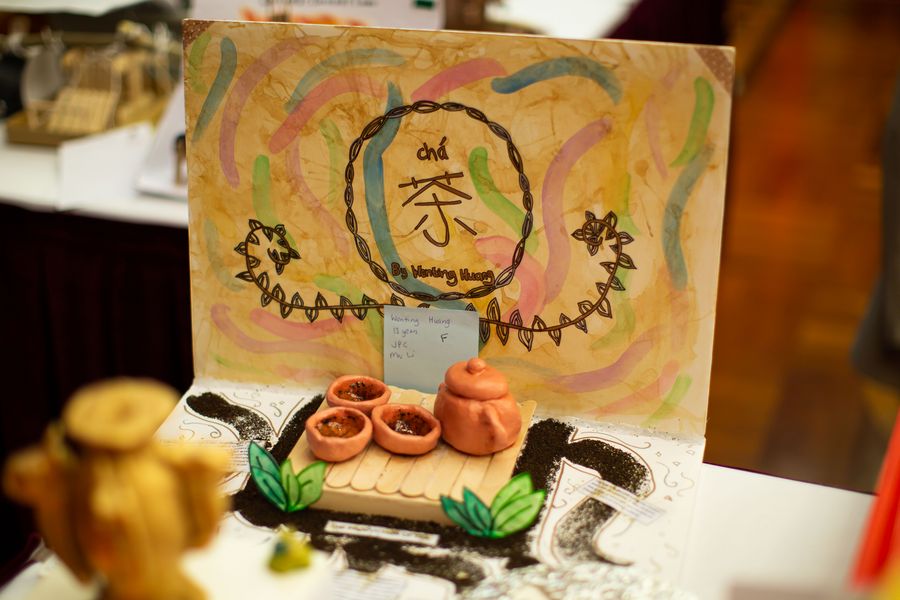Oceania/Australia/10-11-2019/Author(a): huaxia/Source: www.xinhuanet.com
From umbrella to ship, from wood-block printer to brocade loom, from catapult to seismometer and even the ancient Chinese soccer, Australian students’ interpretation of «Chinese inventions» could even surprise some Chinese.
On Wednesday, 87 students from 15 primary and middle schools in Canberra received awards of the Panda Competition in the Chinese Embassy in Australia for their works.

Award-winning works by students are displayed in the Chinese Embassy in Canberra, Australia, Nov. 6, 2019. (Xinhua/Liang Tianzhou)
According to Carol Keil, president of the Australian Capital Territory Branch of the Australia China Friendship Society, the award winners were selected from about 500 candidates.
The number of participants could be higher, «because more put their entries and the teachers chose the best,» she told Xinhua.
This is the 25th year for the competition to be hosted. It was called Panda Competition because topic for the first year was panda.
«Every year we look at a topic, which need to be China-related,» she said. «This year it is inventions. I knew they should be more than just four, so it gave the kids scope to make different things.»
Nathaniel Sircombe, a Year-6 student from Mawson Primary School, made a block printer. Using his printer, he could print some Chinese characters saying «the block printing technique was invented by China».
At first he wanted to make some paper, but after research, he was fascinated by the printing technique.
«Research for the work took about an hour,» said the 12-year-old boy. «But I did a lot of waiting for the paper to dry (after printing).»
Sircombe told Xinhua that his interest in Chinese culture started about seven years ago when he was in the kindergarten. He also began learning Mandarin then.
«We thought it was best to learn a language at a young age,» said his father Keith. «The sooner you start, perhaps the better you get.»
Eight-year-old girl Samantha Gray’s work was a ship carrying silk and porcelain.

Award-winning works by students are displayed in the Chinese Embassy in Canberra, Australia, Nov. 6, 2019. (Xinhua/Liang Tianzhou)
«It took her almost a month to complete it,» said her mother Kanayo Gray. «She made it little by little every day.»
Kanayo Gray was from Japan, and she said that she learned a lot about Chinese invention with her daughter while she was doing research, including ship-building techniques and international trade of ancient China.
Her son, 12-year-old Kenneth Gray from the Mawson Primary School, grabbed the top prize at the competition by making a seismometer with a bucket, tines, pipes and paint. It works like the original one created by Chinese astronomer Zhang Heng about 2,000 years ago. When it was shaken, a ball would come out of the mouth of a dragon pointing in a certain direction, falling into the mouth of a toad beneath it.
«China is a country that developed very quickly, and it made many creations that are interesting,» said the boy.
«I have never heard of seismometer before,» said Carol Keil. «I learned from the students how it works to detect earthquake.»
She noted that learning about another culture «broadens your appreciation of how the world works.»

Award-winning works by students are displayed in the Chinese Embassy in Canberra, Australia, Nov. 6, 2019. (Xinhua/Liang Tianzhou)
«The competition has different topics every year, so they look at something different related to China and Australia,» she said. «In this way they could have a broader understanding of China. I think with the research they do, they will go and look out what the inventions were.»
Yang Zhi, minister-counselor for culture at the Chinese Embassy in Australia, agreed.
«From the works we could see that the children are very creative and full of imagination,» he said. «They searched online and read books. The process itself helps them understand Chinese culture better.»
During the past 25 years, the competition is getting bigger. «It could fuel the enthusiasm of Australian children to learn Chinese culture, and they then would influence their teachers and parents, and ultimately affect the education authorities and promote Chinese language as well.»
Samantha and Kenneth are learning Mandarin as well.
«Chinese is a language for the future,» said their father Collin Gray. He believed that learning the culture and the language would contribute to cross-cultural understanding.
Source and Image: http://www.xinhuanet.com/english/2019-11/07/c_138535473.htm











 Users Today : 69
Users Today : 69 Total Users : 35460200
Total Users : 35460200 Views Today : 98
Views Today : 98 Total views : 3418881
Total views : 3418881